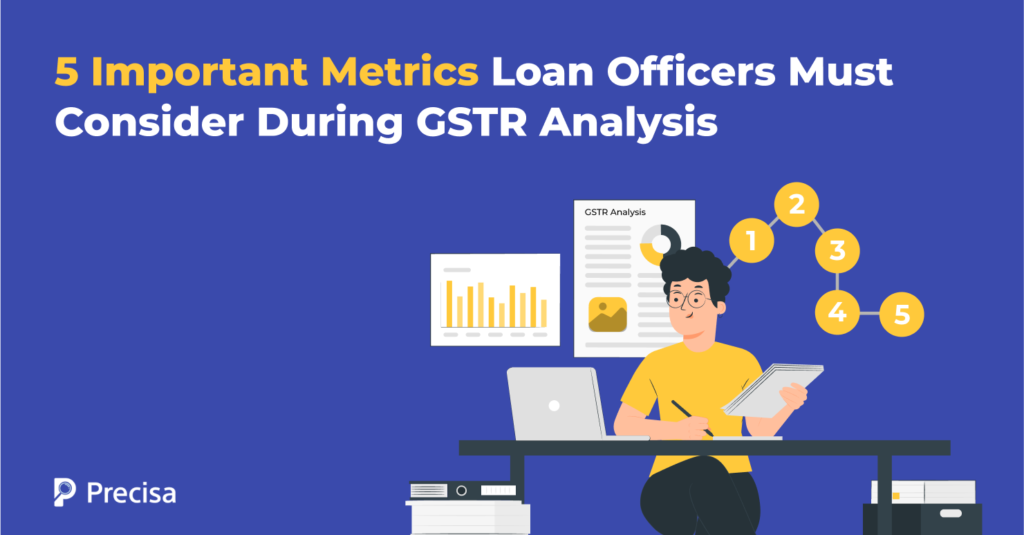
India’s flourishing economy hinges on the success of its ~40 million Micro, Small, and Medium Enterprises (MSMEs), which contribute nearly 30% to the country’s GDP and about 45% to its exports.
However, a few persistent roadblocks, including access to timely credit, continue to hinder MSMEs’ potential growth and scalability.
For lenders, evaluating the creditworthiness of MSMEs isn’t straightforward, particularly when there are discrepancies and other inconsistencies in the financial statements submitted by business owners.
This is where Goods and Service Tax Returns (GSTR) analysis can help lenders gain invaluable insights into an MSME’s financial health, operational efficiency, and compliance record.
This article examines key GSTR analysis metrics that every lender must consider while evaluating and approving MSME loans.
What is GSTR Analysis?

As the name suggests, GSTR analysis involves a thorough analysis of raw data uploaded to the GSTN server to obtain a clear picture of a registered business’s sales and purchases over a stipulated time.
This process is critical to ensure compliance with GST regulations and assess the financial discipline and health of businesses, including MSMEs.
5 Important Metrics to Consider During GSTR Analysis
Now, let’s look at some key metrics lenders should take into account during GSTR analysis to minimise fraud and make informed lending decisions:
1. Turnover Analysis
The Government of India updated the MSME criteria and classifications based on a business’s investment and turnover limits in 2020, replacing the previous investment-only carrier.
The revised turnover and investment limit for different MSMEs are:
Micro Enterprise
- Investment: ₹1 crore
- MSME turnover limit: ₹5 crore
Small Enterprise
- Investment: ₹10 crore
- MSME turnover limit: ₹50 crore
Medium Enterprise
- Investment: ₹50 crore
- MSME turnover limit: ₹250 crore
It is worth noting that if the company’s turnover crosses the ₹250 crore threshold, it cannot reap the incentives and benefits as it is classified as a large enterprise.
Lenders must verify the status of the MSMEs according to the new guidelines accurately to ensure they are eligible for government subsidies and benefits, comply with the lending policies, and are fairly assessed.
2. Tax Payment Patterns
One of the most important parameters that loan officers must inspect is the frequency of filing and paying GST to identify delays and default rates. Regular delays or multiple defaults indicate that the business may have cash flow-related problems.
Additionally, monitoring a company’s claimed Input Tax Credit (ITC) is critical to assessing its purchasing trends and overall efficiency while managing working capital.
The details related to tax liability declared in GSTR-3B should match the amount paid to minimise inconsistencies and ensure compliance.
3. Supplier Analysis
Lending officers must determine the GST compliance of a business’s suppliers since the ITC primarily depends on it.
Lenders must evaluate whether the supplier base of the MSME in contention for a loan has declared their outward supplies in GSTR-1, including details such as applicable tax, customer GSTIN, and invoice details.
Additionally, the supplier must also pay the mandatory GST liability according to the details mentioned in GSTR-3B. The GST system initiates the invoice-matching process once the suppliers file GSTR-1 and GSTR-3B.
So, lenders must assess whether all the transactions between suppliers and the MSME are valid by verifying whether the outward supplies (GSTR-1) and inward supplies declared by the MSME (GSTR-2A) match.
4. GSTR-2A Reconcilaltion
GSTR-2A reconciliation is one of the most important processes for verifying and matching all the invoices added by an MSME in its books.
Lending officers must inspect these records to discover discrepancies and ensure transparency. GSTR-2A reconciliation also enables MSMEs to add missing invoices (if any) and get them uploaded from the supplier to ensure they do not lose any ITC.
This step paints a clear picture of the MSME’s purchasing patterns and the credibility of its suppliers, allowing lending officers to evaluate the financial health and discipline of the business. It also helps them eliminate the risk of fraudulent and mismatched invoices, paving the way for accurate and informed decision-making.
5. GSTR Analysis to Determine Creditworthiness
All the GST-related details mentioned in the previous points provide insights into the MSME’s tax compliance, sales, purchases, and amount of tax paid. This information is useful for lending officers as it helps them determine the MSME’s financial health and make accurate credit assessments.
A detailed GSTR analysis also helps lending officers detect anomalies and potential red flags, including delayed tax payments, inconsistent filings and turnover, mismatched invoices, and incorrect investments.
This data-driven approach aids lenders in assessing the MSME’s creditworthiness and making sound lending decisions.
Customised Credit Cards for MSMEs with 5 Lakh Limit
India’s Union Finance Minister, Nirmala Sitharaman, announced the launch of a personalised credit card scheme for registered MSMEs on the Udyan Portal to accelerate credit accessibility.
The newly launched MSME credit card is tipped to be a game-changer, simplifying loan assessments and disbursement – a win-win situation for lenders and borrowers.
- The move comes at the back of the persistent challenges tied to financial accessibility for small businesses and aims to improve financial inclusion and competitiveness within the MSME sector.
- The card is expected to integrate with the current GST system, enabling lenders to access key financial data of MSMEs relevant to the specialised MSME credit card.
- This includes tax payments, outward payments to suppliers, and inwards received from customers.
Parting Notes
GSTR analysis is a powerful mechanism for lenders to assess the financial status and discipline of MSMEs along with their creditworthiness and compliance. With these important parameters, including tax payment patterns, supplier credibility, GSTR-2A reconciliation, and turnover limits, lenders can make informed lending decisions backed by data.
While the Indian government continues to push to improve financial inclusion, lending officers must leverage data available on the GSTN portals to streamline and fast-track loan disbursement without turning a blind eye to due diligence.
To streamline and enhance the accuracy of GSTR analysis, lending officers can leverage Precisa, an advanced financial analytics platform designed to simplify tax and credit evaluations. It provides AI-powered insights into an MSME’s financial health by automating GST data extraction, reconciliation, and validation.
With its real-time data processing, error detection, and comprehensive risk assessment tools, Precisa enables lenders to identify inconsistencies, assess tax compliance, and confidently make data-driven credit decisions.
To learn more, schedule a demo now!